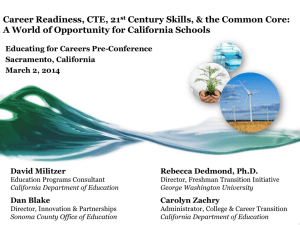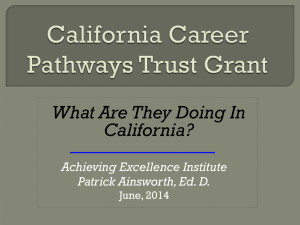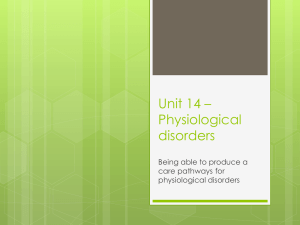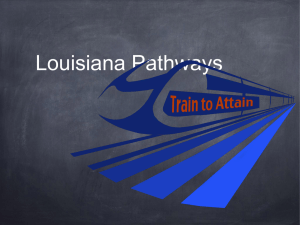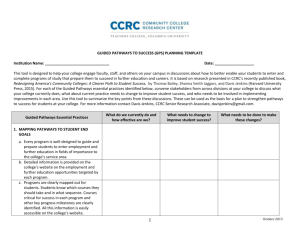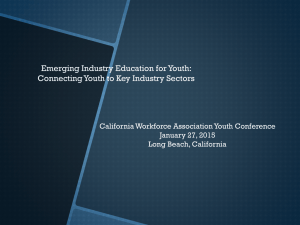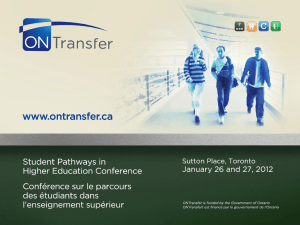(CTE) in CAREER Pathways SYSTEMS
advertisement
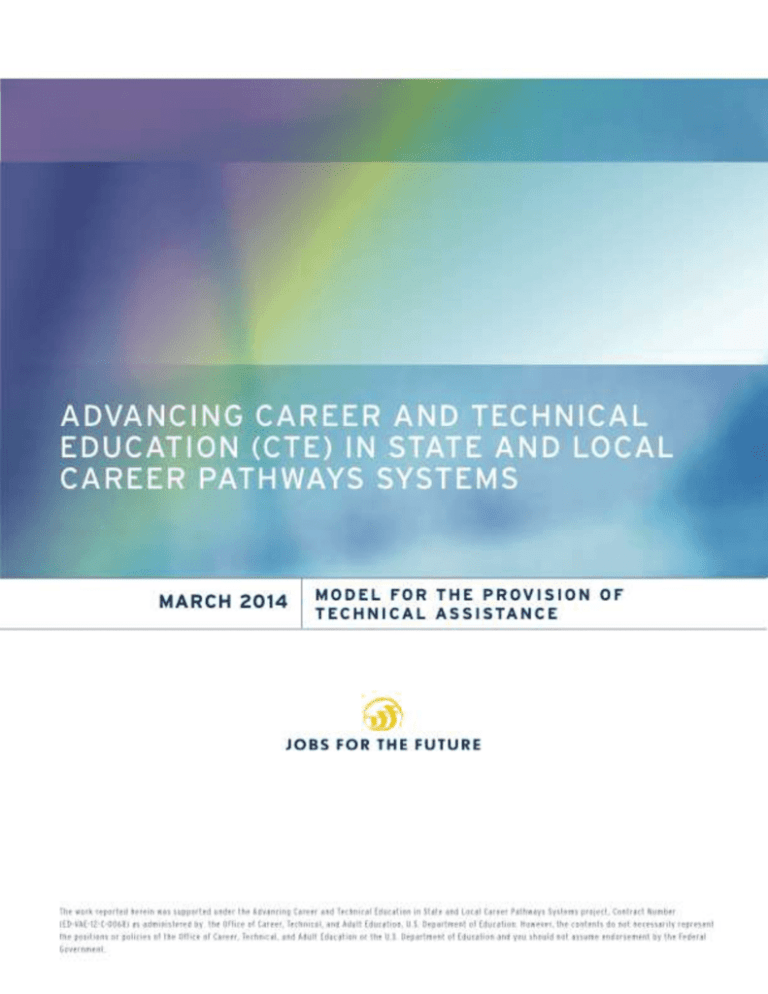
ADVANCING CAREER AND TECHNICAL EDUCATION (CTE) IN CAREER PATHWAYS SYSTEMS INTEGRATED MODEL I. INTRODUCTION AND PURPOSE OF THE INITIATIVE THE OPPORTUNITY Across the nation, education and workforce development systems are responding to increasing employer demand for academic, employability and technical skills among employees. As postsecondary credentials have become the key to a middle class standard of living, education and training systems are all working to help both youth and lower-skilled adults access and succeed in postsecondary credential programs with labor market value. This includes the country’s K-12 and postsecondary education systems, particularly Career and Technical Education (CTE) programs within those systems, and our adult education and workforce development systems. Given their common goals, the traditional autonomy of these education and training institutions no longer makes sense. For this reason, innovators are reaching out across system boundaries to develop more robust pathways to industry-recognized postsecondary credentials and family-sustaining employment. ADULT CAREER PATHWAYS The past decade has seen a dramatic increase at the state, regional and institutional levels in the development of Career Pathways, which are designed to bring greater efficiency and transparency to the routes from adult education programs, non-credit training, or other starting points to credentials recognized by industry and postsecondary educational institutions. Built around integrated academic and technical education pathways, Career Pathways enable individuals to progress through a modular system of postsecondary credentials that build upon each other, leading to further credentials and improved employment prospects. The work reported herein was supported under the Advancing Career and Technical Education in State and Local Career Pathways Systems project, Contract Number (ED-VAE-12-C-0068) as administered by the Office of Career, Technical, and Adult Education, U.S. Department of Education. However, the contents do not necessarily represent the positions or policies of the Office of Career, Technical, and Adult Education or the U.S. Department of Education and you should not assume endorsement by the Federal Government. 2 ADVANCING CAREER AND TECHNICAL EDUCATION (CTE) IN CAREER PATHWAYS SYSTEMS INTEGRATED MODEL Increasingly, Career Pathways Systems are being forged at the state level. There, policy reforms have helped to: identify high-demand occupations; carry out collaborative approaches to the development and expansion of pathways for students at different levels of preparedness; and provide incentives (e.g., performance based funding, enhanced FTE, state-based funding) to promote and reward more effective, transparent pathways to postsecondary credentials and employment. Career Pathways collaborations have also emerged in occupational or industry clusters, where providers and employers unite to align systems in ways that lead to industryrecognized credentials and quality employment. The federal government, led by the Departments of Education, Labor, and Health and Human Services, has been an active proponent of Career Pathways Systems, through conferences and webinars, research, toolkits, virtual communities of practice, and competitive grants. In April 2012, the Department of Labor’s Employment and Training Administration (ETA), the Department of Education’s Office of Career, Technical, and Adult Education (OCTAE), and the Department of Health and Human Services’ Administration on Children and Families (ACF) issued a joint letter of support for Career Pathways that provides structure for this work (http://www2.ed.gov/about/offices/list/ovae/ten-attachment.pdf) (See Appendix One). CTE PROGRAMS OF STUDY As Career Pathways Systems for adults have been evolving and maturing, a parallel effort has taken shape in CTE systems and institutions that prepare young people for college and careers. The 2006 reauthorization of the Carl D. Perkins Career and Technical Education Act (Perkins IV) emphasized the importance of alignment between secondary and postsecondary CTE programs so that young people can move efficiently and quickly to and through postsecondary education and training systems. Perkins IV called on states to support the creation of Programs of Study (POS), an educational option that incorporates and aligns secondary and postsecondary elements. In a coordinated, non-duplicative progression of courses leading to industryrecognized credentials or degrees at the postsecondary level, it includes, where appropriate, the opportunity for high school students to earn college credits. 3 ADVANCING CAREER AND TECHNICAL EDUCATION (CTE) IN CAREER PATHWAYS SYSTEMS INTEGRATED MODEL Since 2006, there has been progress by states, local communities and partners working with the Department of Education’s Office of Career, Technical, and Adult Education (OCTAE) to define and identify 10 essential components of CTE Programs of Study. The definition and essential components of Programs of Study were developed in order to help schools and their partners create more structured pathways, with multiple entry and exit points that lead to postsecondary education and careers in high demand occupations (http://cte.ed.gov/nationalinitiatives/rposdesignframework.cfm). In effect, the development of CTE Programs of Study has followed a parallel evolution to Career Pathways serving adults. The design elements and goals of Programs of Study are similar to those of Career Pathways—as are the system-building efforts of state and local stakeholders. However, because these two reform efforts are shaped by different legislative directives, delivery systems and funding streams, and engage different public systems and populations, CTE Programs of Study and Career Pathways efforts frequently function in relative isolation from each other. Rare is the state where the two efforts learn with and from each other, reinforce each other, and move forward in a coordinated and aligned way. 4 ADVANCING CAREER AND TECHNICAL EDUCATION (CTE) IN CAREER PATHWAYS SYSTEMS INTEGRATED MODEL A Missed Opportunity Graphic 1 This disconnect is a lost opportunity (see Graphic 1). These two systemic change strategies share many common features, including the alignment of policies and programs across levels, the development of strategic cross-agency and cross-sector partnerships, and expectations for crosssystem accountability and program improvement. In too many communities, the failure to bring these two systems into closer coordination and alignment has resulted in inefficiencies, weaker implementation and policy confusion. Duplication of effort is common: programs developed for CTE are re-invented by adult-serving systems—or vice-versa. Uncoordinated efforts to engage employers result in the alienation of otherwise interested employers and confusion over how best to participate and advance their interests. The isolation of the two systems has also led to a confusing proliferation of program terminology, services, and accountability measures, some 5 ADVANCING CAREER AND TECHNICAL EDUCATION (CTE) IN CAREER PATHWAYS SYSTEMS INTEGRATED MODEL unique to CTE Programs of Study and others to Career Pathways, neither very different at their core. Again, this comes at a cost. The Office of Career, Technical, and Adult Education, working closely with the Employment and Training Administration, has taken the initiative to try to break down these counterproductive silos and encourage closer alignment of CTE Programs of Study and Career Pathways programs in communities and at the state level. Both agencies recognize the value of greater alignment across the two systems in terms of efficiency, replicability and adaptability, alignment of resources and incentives, and clear signals to educational institutions, employers, and students about the road ahead (see Graphic 2). Graphic 2 6 ADVANCING CAREER AND TECHNICAL EDUCATION (CTE) IN CAREER PATHWAYS SYSTEMS INTEGRATED MODEL TOWARD AN ALIGNED MODEL FOR YOUTH AND ADULTS: ALIGNING CTE PROGRAMS OF STUDY WITH CAREER PATHWAYS SYSTEMS Implementing an integrated Career Pathways System requires alignment across education, training, employment and support services. It also requires collaboration among secondary and postsecondary career and technical education, adult education, and workforce training systems and agencies. OCTAE has contracted with Jobs for the Future (JFF) and its partners to help states accelerate their efforts to strengthen and align these efforts. Over the next two years, technical assistance and peer learning opportunities will guide states’ efforts to align CTE Programs of Study with Career Pathways System development efforts (see Graphic 3). One component of the technical assistance that will emerge from this work is a set of tools that illustrate how the ten components in the Rigorous Programs of Study framework align with the Career Pathways six key elements; and how the integration of these two efforts can strengthen one another. This guide is a first attempt to construct and present that combined model. We assume the integrated design model will evolve over time as states provide feedback, but we also feel that this initial guide can assist states to build comprehensive Career Pathways Systems that will help young people and adults earn high value postsecondary credentials. 7 ADVANCING CAREER AND TECHNICAL EDUCATION (CTE) IN CAREER PATHWAYS SYSTEMS INTEGRATED MODEL Graphic 3 Note: The Graphic above depicts how the Career Pathways Six Key Elements and the Programs of Study Ten Essential Components can Align to Establish a Comprehensive Career Pathways System (also see table 2). 8 ADVANCING CAREER AND TECHNICAL EDUCATION (CTE) IN CAREER PATHWAYS SYSTEMS INTEGRATED MODEL II. ALIGNING THE CTE PROGRAMS OF STUDY AND CAREER PATHWAYS FRAMEWORKS Agreed Upon Definition of Career Pathways by the U.S. Departments of Labor, Education, Health and Human Services A series of connected education and training strategies and support services that enable individuals to secure industry relevant certification and obtain employment within an occupational area and to advance to higher levels of future education and employment in that area. FIRST STEP: COMPARING CURRENT DEFINITIONS As noted above, the federal government has supported the development of definitions and frameworks for both Career Pathways and CTE Programs of Study. Though not yet aligned in most places, these initiatives share many common elements. The Advancing Career and Technical Education in State and Local Career Pathways Systems project is intended to assist states and local communities to recognize these common features, and to integrate CTE programs of study into broader Career Pathways efforts. As shown in the next few pages, these common elements and activities in the Programs of Study and Career Pathways structures provide a helpful starting point for establishing a shared model. It should be noted however, that this effort is not intended to replace the Rigorous Programs of Study framework and its ten Career Pathways should include: Alignment of secondary and postsecondary education with workforce development systems and human services; Rigorous, sequential, connected, and efficient curricula, that “bridges” courses to connect basic education and skills training and integrate education and training; Multiple entry and exit points; Comprehensive support services, including career counseling, child care and transportation; Financial supports or flexibility to accommodate the demands of the labor market in order to allow individuals to meet their ongoing financial needs and obligations; Specific focus on local workforce needs, aligned with the skill needs of targeted industry sectors important to local, regional or state economies, and reflective of the active engagement of employers; Curriculum and instructional strategies appropriate for adults, that make work a central context for learning and work readiness skills; Credit for prior learning and other strategies that accelerate the educational and career advancement of the participant; Organized services to meet the particular needs of adults, including accommodating work schedules with flexible and nonsemester-based scheduling, alternative class times and locations, and the innovative use of technology; Services that have among their goals a focus on secondary and postsecondary industry recognized credentials, sector specific employment, and advancement over time in education and employment within a sector; and Is founded upon and managed through a collaborative partnership among workforce, education, human service agencies, business, and other community stakeholders. OCTAE-Supported CTE Programs of Study Definition CTE programs of study at a minimum, must: Incorporate and align secondary and postsecondary education elements; Include academic and CTE content in a coordinated, nonduplicative progression of courses; Offer the opportunity, where appropriate, for secondary students to acquire postsecondary credits; and Lead to an industry-recognized credential or certificate at the postsecondary level, or an associate or baccalaureate degree. components as that work remains vital to the development of Programs of Study. 9 ADVANCING CAREER AND TECHNICAL EDUCATION (CTE) IN CAREER PATHWAYS SYSTEMS INTEGRATED MODEL Both Career Pathways and CTE Programs of Study are defined in their federally sponsored initiatives to include: Alignment of secondary and postsecondary education Connected, sequential, non-duplicative curricula that includes both academic/ basic education content and CTE/skills training Opportunities to earn college credit and accelerate credential attainment Emphasis on the attainment of postsecondary, industry-recognized credentials, though Programs of Study tend to identify such credentials in connection with states’ work on the identification of Career Clusters; and Career Pathways systems are encouraged to take into account the DOL Competency model for the identification of needed skills and credentials. Given that the low-skilled adult population has different needs and constraints than the high school student population who participates in the secondary component of Programs of Study, there are some purposeful differences between the Career Pathways and Programs of Study definitions, including Career Pathways’ prioritization of: Stackable credentials with value in the labor market The degree of focus on support services and financial supports Instructional strategies and course offerings designed to meet the needs of working adults. 10 ADVANCING CAREER AND TECHNICAL EDUCATION (CTE) IN CAREER PATHWAYS SYSTEMS INTEGRATED MODEL NEXT STEP: A CROSSWALK OF THE CAREER PATHWAYS AND CTE PROGRAMS OF STUDY FRAMEWORKS The crosswalk (see Tables 1 and 2) on the next page highlights the considerable overlap between the definitional frameworks developed for Career Pathways and Programs of Study. While there are many similarities between Career Pathways and Programs of Study, there are also important differences. For example, the Career Pathways framework focuses more on the systems-level elements that support Career Pathways development while the Programs of Study framework focuses more on programmatic features, such as curriculum and content standards, and professional development. The Programs of Study framework emphasizes the needs of secondary students and their transitions to and through postsecondary education and training; while the current Career Pathways framework tends to focus on the needs of low-skilled adults as they transition to and through postsecondary education and training. The following table shows the Six Key Elements identified for Career Pathways and the Ten Essential Components for Programs of Study, followed by a crosswalk that details the similarities between the two initiatives, a comparison that should help states and local communities align these two approaches more effectively and easily. Table 1 Career Pathways Six Key Elements Programs of Study 10 Essential Components 1) Build Cross-Agency Partnerships 1) Legislation and Policies 2) Identify Industry Sectors and Engage Employers 2) Partnerships 3) Design Education and Training Programs 4) Accountability and Evaluation Systems 4) Align Policies and Programs 5) College and Career Readiness Standards 5) Identify Funding Needs and Strategies 6) Course Sequences 6) Measure System Change and Performance 7) Credit Transfer Agreements 3) Professional Development 8) Guidance, Counseling, Academic Advisement 9) Teaching and Learning Strategies 10) Technical Skills Assessment 11 ADVANCING CAREER AND TECHNICAL EDUCATION (CTE) IN CAREER PATHWAYS SYSTEMS INTEGRATED MODEL Table 2 CAREER PATHWAYS (CP) SIX KEY ELEMENTS PROGRAMS OF STUDY (POS) TEN COMPONENTS COMMON FEATURES 1. Build CrossAgency Partnerships #2: Partnerships 2. Identify Industry Sectors and Engage Employers #2: Partnerships #10: Technical Skills Assessment Cross-agency partnerships include education, business, workforce, economic development and community stakeholders Common vision and goals Clearly delineated and agreed upon roles/responsibilities for all partners Both CP and POS frameworks stress the analysis and validation of economic and workforce trends, and adaptation of pathways accordingly 3. Design Education and Training Programs #5: College and Career Readiness Standards #6: Course Sequences #7: Credit Transfer Agreements #8: Guidance Counseling and Academic Advising #9: Teaching and Learning Strategies #10: Technical Skills Assessment #3: Professional Development 4. Align Programs and Policies #1: Legislation and Policies #3: Professional Development (policy implications) #1: Legislation and Policies 5. Identify Funding Needs and Strategies 6. Measure Systems Change and Performance #4: Accountability and Evaluation Systems #10: Technical Skills Assessment Clear, non-duplicative sequences of course Opportunities to earn college credit leading to industryrecognized, postsecondary credentials Credit transfer / articulation agreements Counseling, including career planning and academic advisement Support services, especially in CP Contextualization and modularization of curricula, and mapping of pathways Integrated instruction of academic and technical content, acceleration (dual enrollment in POS; co-enrollment in CP) Instructional strategies that instill work readiness skills Emphasis on the role of federal, state, and local policies in promoting and sustaining CP and POS; and in helping students access CP and POS services Braided or integrated funding from multiple funding sources to provide sufficient resources and sustain programs Importance of funding to support professional development and other system development activities Importance of defining outcomes/ measuring progress Processes for collecting, storing, analyzing and sharing data are encouraged in both CP and POS frameworks 12 ADVANCING CAREER AND TECHNICAL EDUCATION (CTE) IN CAREER PATHWAYS SYSTEMS INTEGRATED MODEL III. AN INTEGRATED MODEL FOR ALIGNING PROGRAMS OF STUDY AND CAREER PATHWAYS SYSTEMS: STATE PRIORITIES AND STRATEGIES Successful efforts to integrate CTE Programs of Study with Career Pathways Systems development will require a commitment from multiple partners to working together toward greater transparency, alignment and systemic change. To assist with this process, JFF has integrated the joint consensus definition and framework for Career Pathways, with OCTAE’s Programs of Study definition and components into a single model to help states and local communities identify priorities, opportunities and strategies for developing comprehensive Career Pathways Systems that include CTE programs of study. This model as well as Graphic 4 should help states and local communities visualize how a comprehensive Career Pathways System can serve both high school age youth as well as adults. And it should promote collaboration, alignment and cross-system development of structured pathways into and through postsecondary credential programs. The model, presented in Table 3, will serve as the guiding structure for the tools, resources and coaching provided throughout this initiative, as well as for the milestones against which state and local progress will be measured. It is organized around the six key elements of comprehensive Career Pathways Systems and incorporates the Programs of Study Ten Components. For each element, a short definition and description is provided, capturing what it would look like for states to pursue policies and promote strategies that advance Programs of Study and Career Pathways in a more coherent and synergistic way. The model goes a step further, identifying strategies, most taken from state efforts around the country, that are proving effective in the design, delivery, and diffusion of a better aligned system engaging both CTE Programs of Study and Career Pathways. Over the course of this initiative, JFF will further expand and adapt this model so states can use it to guide their planning, implementation and support efforts. We intend for this model to be a living document that is improved through experience and learning over time—and that it becomes a touchstone for other states nationally, not just the states participating in this initiative. 13 ADVANCING CAREER AND TECHNICAL EDUCATION (CTE) IN CAREER PATHWAYS SYSTEMS INTEGRATED MODEL Graphic 4 14 ADVANCING CAREER AND TECHNICAL EDUCATION (CTE) IN CAREER PATHWAYS SYSTEMS INTEGRATED MODEL Table 3. Integrated Model for Comprehensive Career Pathways Systems 1. BUILD CROSS-SYSTEM PARTNERSHIPS 2. ENGAGE EMPLOYERS, IDENTIFY KEY INDUSTRIES AND ALIGN SYSTEM WITH INDUSTRY NEEDS Building comprehensive Career Pathways Systems that include CTE programs of study requires the alignment of multiple federal, state and local programs, and a commitment to changes that span multiple state and local agencies, and the public and private sectors (including employers in high demand industry sectors and occupations). To succeed, states and local communities must forge partnerships that bring together a wide range of state/local agencies, employers, community-based organizations and other system stakeholders to agree upon a common vision and goals for the comprehensive career pathways system. Comprehensive Career Pathways Systems must allow students to earn industry-recognized, postsecondary credentials that correspond to the skill needs of employers in high demand industries. In addition, comprehensive Career Pathways Systems must develop shared processes for: identifying the skills that are in-demand in the state and in regional economies; determining how students are deemed proficient in these skills; and determining how employers can best validate curriculum and credential alignment. Strategies: Strategies: Establish a career pathways team that includes state and local leaders from across secondary and postsecondary education (including CTE), adult education, workforce development, human services, economic development, justice and the private sector, including employers from high demand industry sectors and occupations. Use multiple-dataset labor market analyses, real time data, and employer advisory groups or partnerships to inform high demand industry sector identification, as well as curriculum and system design. Conduct service mapping to identify shared goals, services, resources, and performance measures across partner programs. Compare capacity of education and training systems to needs of employers, identify and address skills gaps. Agree upon and clearly define the roles and responsibilities of each partner for the development and implementation of the comprehensive Career Pathways system, formally committing to those roles and responsibilities in a memorandum of understanding (MOU), ensuring that all partners are empowered to make or influence decisions. Identify a lead and coordinator at the state and local levels to coordinate day-to-day operations, convene partners, broker opportunities, lead planning, and evaluate the development and progress of the comprehensive Career Pathways System. Target high-demand industry sectors for establishment of pathways in the comprehensive Career Pathways System. Identify key employers as partners from the targeted sectors and provide unified outreach. Utilize technical skills assessments that: o Measure skills attainment and the application of knowledge at multiple points along a pathway; o Use industry-recognized assessments and credentials; use state assessments where industry credentials do not exist; o Award postsecondary credit and/or industry recognized credentials Use partnerships with employers to regularly test the validity of technical skills expectations and credentials. Incorporate “employability” or “soft” skills into technical skills curricula and instructional strategies. (cte.ed.gov) 15 ADVANCING CAREER AND TECHNICAL EDUCATION (CTE) IN CAREER PATHWAYS SYSTEMS INTEGRATED MODEL 3. REDESIGN PROGRAMS TO ACHIEVE SYSTEM GOALS 4. PURSUE NEEDED FUNDING, SUSTAINABILTY AND SCALE Program redesign is essential to Career Pathways Systems change and should incorporate elements that promote student success and timely progress to completion, credential attainment, and entry into or progress within careers in high demand occupations. Pathways must be flexible, nonduplicative and accelerated –structured to accommodate the unique needs of youth and adults. Each education level must be carefully articulated to the next, without duplication, with effective academic and career supports and counseling, particularly at points of entry and transition. Declining federal, state and local education and training investments, combined with the cross-agency nature of comprehensive Career Pathways System redesign, makes “braided funding” a critical strategy to pay for the costs of student participation, particularly in postsecondary education and training; and for program development and implementation. This approach paired with efforts to raise additional funding (including alternative financing strategies) and to provide incentives for career pathways development among system stakeholders, will provide a foundation for sustaining and scaling aligned pathways for youth and adults. Strategies: Strategies: Ensure course content, credit and credentials are sequential and non-duplicative, with one education level articulated to the next so students’ progress along pathways results in credential attainment and/or a degree, and in employment or progression in a high demand career. Identify costs associated with system redesign, development and operations; and costs associated with student participation, particularly at the postsecondary level (e.g., tuition, books). Ensure that curricula are aligned with rigorous college and career readiness standards. Design secondary level courses along the lines of a skills pyramid, with broad foundational content offered at the introductory level, applying to the many careers encompassed within a cluster, with courses becoming more occupationally focused and skills-specific as students progress to the postsecondary level. Organize coursework for adults to meet their needs, including modularized curricula, stackable credentials with value in the labor market (with programs built and organized around DOL competency models that may also follow the lines of a pyramid, to the extent practicable); non-semesterbased scheduling, alternative class times and locations; and the innovative uses of technology. http://www.careeronestop.org/competencymodel Identify areas of overlap especially between Programs of Study and adult Career Pathways; explore ways system alignment may lead to efficiencies and savings. Conduct unified outreach to raise awareness and build support for comprehensive Career Pathways among key stakeholder groups including business leaders and policymakers. Identify and seek out new funding sources and implement new funding strategies to “braid” multiple funding sources (including local, state and national public and private initiatives). Examine opportunities for alternative financing (e.g., bond financing, augmented FTE, employer-provided training, apprenticeships). Jointly develop a sustainability plan. Jointly set goals for scaling. Provide comprehensive academic and career counseling to students at all levels, particularly at the beginning of a POS/CP, and at points of transition along the pathway. Identify and promote opportunities for secondary students to engage in dual enrollment (high school and postsecondary education courses), and for low-skilled adults to engage in co-enrollment (adult education and postsecondary occupational training)—allowing students to earn college credit while still in high school or in adult education programs, respectively. 16 ADVANCING CAREER AND TECHNICAL EDUCATION (CTE) IN CAREER PATHWAYS SYSTEMS INTEGRATED MODEL Program Redesign Continued. Promote interdisciplinary planning and teaching among academic and CTE teachers, and postsecondary technical and basic skills instructors (for low-skilled adults), with the goal of integrated instruction and acceleration. Use contextualized content and instructional strategies that teach team building, critical thinking, communication and other work-readiness competencies. Incorporate prior-learning assessments and competencybased education and training models wherever possible, particularly at the postsecondary level Develop career maps that can be used across secondary and postsecondary systems, resulting in credential or degree attainment and in high demand careers Identify, validate and keep current technical and workforce readiness skills (using industry developed or recognized assessments and credentials with value in the labor market where available, and state developed assessments and credentials where industry-recognized qualifications do not exist). 17 ADVANCING CAREER AND TECHNICAL EDUCATION (CTE) IN CAREER PATHWAYS SYSTEMS INTEGRATED MODEL 5. IDENTIFY AND PURSUE NEEDED POLICY CHANGES 6. IDENTIFY AND IMPLEMENT CROSS-SYSTEM DATA AND ACCOUNTABILITY SYSTEMS Each state and local area that is involved in the development of a comprehensive Career Pathways System has a unique set of statutory and administrative policies that affect their ability to align programs and achieve cross-system goals. Similarly, each participating state and local agency sets and/or oversees statutory requirements, rules, regulations, goals and performance measurement requirements that govern the programs under their jurisdiction. These policies and procedures must be identified, analyzed and changed when they act as barriers to system alignment and to the development of comprehensive Career Pathways Systems. Similarly, new policies to encourage better alignment and outcomes should be implemented. To measure the impact of comprehensive Career Pathways Systems, states must find ways to measure cross-system performance and participants’ progress beyond what is required for individual program performance accountability and data collection within individual agencies. Cross-system data collection, analysis and performance measurement should be a priority. Identifying appropriate cross-system outcome measures and holding partner provider systems accountable for making progress based on those measures will require the development of structures and strategies for gathering and sharing quantitative and qualitative data across agencies and partners. Strategies: Strategies: Conduct a cross-agency policy audit (at the state and local levels) to determine points of alignment across participating programs and agencies, as well as barriers to collaboration. Identify system changes and performance indicators, including the participant outcomes that are needed to determine the effectiveness of a comprehensive Career Pathways system that extends from secondary CTE and Adult Education to and through postsecondary credential attainment and employment in high demand occupations. Once a policy audit is completed, identify policy changes that are needed, statutory or administrative, to eliminate barriers and to drive the systemic changes that are necessary for development of a comprehensive Career Pathways System in the state and local area. In addition to formal policy barriers to system alignment, state and local teams should also examine informal, perceived policy and cultural impediments to systems change that stand in the way of progress (at state, local and institutional levels). Working as a team, identify and make those changes that can be made across agencies and institutions without legislative or complex administrative actions (e.g., informal policy or cultural changes); work to craft and build support for more complex legislative and administrative changes that are necessary. Examples of changes that may be pursued include policies ranging from encouragement for dual and co-enrollment; statewide articulation agreements; increased flexibility for student aid eligibility; to elimination of barriers to crosssystem alignment Ensure college and career readiness standards are: o Consistent across secondary and postsecondary systems; o Reflective of math and English knowledge levels expected of high school graduates; and o Incorporate industry-recognized technical standards Align state databases, either through sharing agreements or through incorporation into a P-20 data warehouse, and consider how data will be stored, tracked and shared. Focus on improvements to metrics and data collection methods. Set long- and short-term goals; measure progress against them. Provide timely data evaluating effectiveness of alignment. Ensure data is used to drive decision-making. o Use disaggregated data to identify and close participation, educational attainment and employment gaps between different student populations. 18 ADVANCING CAREER AND TECHNICAL EDUCATION (CTE) IN CAREER PATHWAYS SYSTEMS INTEGRATED MODEL IV. CONCLUSION The Advancing Career and Technical Education (CTE) in State and Local Career Pathways Systems project is designed to help states and local communities integrate CTE Programs of Study into their broader Career Pathways System development efforts. Outcomes from this initiative are expected to yield: Improved opportunities for students, beginning in secondary school for school-aged youth or in adult education programs for low-skilled adults, to enter into pathways that will take them to and through postsecondary education; Greater numbers of individuals who attain industry-recognized credentials and degrees with value to employers in the state and regional labor markets; and Increased numbers of individuals who attain employment in high demand industries and occupations. Many states have embraced the development of Career Pathways Systems, particularly for meeting the education and training needs of low-skilled adults. At the same time, states are developing rigorous Programs of Study within their CTE systems that expand opportunities for secondary CTE students to advance in postsecondary education and training that leads to industry-recognized credentials or degrees, and to good jobs. While Career Pathways and Programs of Study share similar design features and intended goals, these efforts are developing on parallel tracks. This misalignment is inefficient at best, and counterproductive to the development and delivery of the highest quality and most relevant services for students, jobseekers, workers and employers. This project is intended to bridge these efforts—taking the best of both initiatives to build comprehensive Career Pathways Systems that lead young people and adults alike to the attainment of industry-recognized postsecondary credentials and to family sustaining careers in high demand industries and occupations. 19
